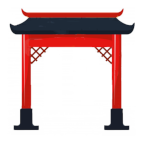| Meaning |

use, need 用
|
| Explanation |
|
Used in these characters:
|
|
用
|
 |
|
JLPT HSK 3 |
|
| to use, employ, have to, to eat or drink
yòng
用
 |
|
Image of a fence
A fence can be used.

|
|
|
|
拥
|
 |
|
JLPT HSK 5 |
|
| to embrace, to wrap around, throng, swarm
|
Left: hand 扌, right: use, employ 用 (A fence 用 can be used.)
The hand is used for embracing.

|
|
|
|
甩
|
 |
|
JLPT HSK 5 |
|
| to throw, to fling, to swing, to leave behind
|
Variation of to use, employ 用 (A fence 用 can be used.)
Use 用 sth. with a 'handle' 乚 for: throwing.

|
|
|
|
庸
|
 |
|
JLPT HSK 6 |
|
| ordinary, to use (often negative)
|
Outside: building 广, below: hand  , holding a pestle 丨, combined with use 用 , holding a pestle 丨, combined with use 用
When in a building a hand uses a pestle, it is very ordinary.

|
|
|
|
佣
|
 |
|
JLPT HSK 6 |
|
| to employ, to hire, servant
yōng, yòng
亻
用
 |
|
Left: person 亻, right: to use, need 用 (A fence 用 can be used.)
The person, who is used is the: employed servant.

|
|
|
|
甭
|
 |
|
JLPT HSK 6 |
|
| need not, not necessary
|
Top: not 不 (Four strokes are not enough!), bottom: use, need 用 (A fence is needed.)
"Not needed" means: Not necessary!

|
|
|
|
甫
|
 |
|
JLPT no HSK |
|
| just, just now
|
Image of the upper body with shoulders 一 and chest 月 (with ribs) and spine 丨 and something 丶 is sitting on the shoulder, perhaps a bird?)
There is a small thing on the shoulder: just now!

|
|
|
| Radicals are shown here that are similar either in appearance or meaning. |  |
|
At the page you get the memory phrases for learning the Chinese Hanzi. If you are learning the Japanese kanji, please follow this link. |
List of the characters |
List of the radicals
|

